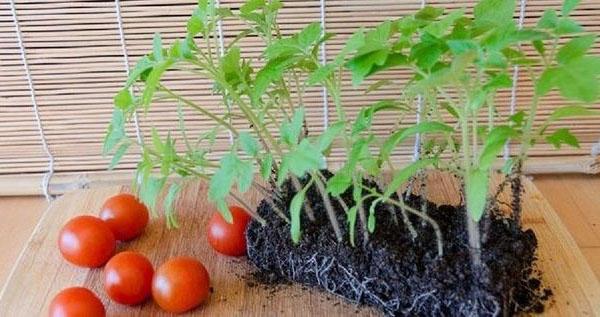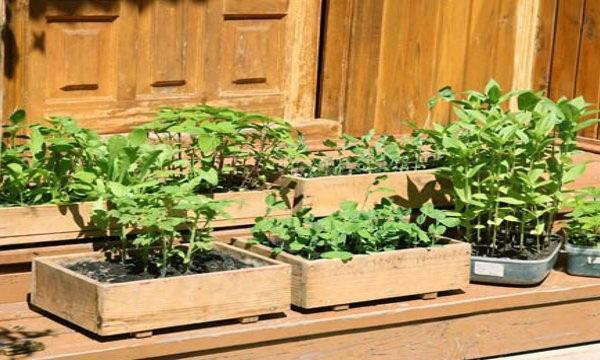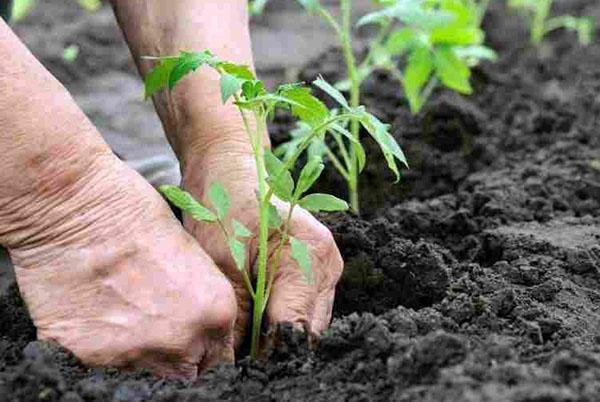Terms and rules for planting tomato seedlings in open ground
 Tomatoes are heat-loving plants, so it's important to know how to plant them. Many do not know when to plant tomatoes in open ground and make mistakes that can affect the harvest. One of the most important and crucial moments is planting seedlings. However, before starting this process, the seedlings need to be well prepared for such an important stage. After all, it is after planting that tomatoes begin to actively grow and develop.
Tomatoes are heat-loving plants, so it's important to know how to plant them. Many do not know when to plant tomatoes in open ground and make mistakes that can affect the harvest. One of the most important and crucial moments is planting seedlings. However, before starting this process, the seedlings need to be well prepared for such an important stage. After all, it is after planting that tomatoes begin to actively grow and develop.
How to properly prepare seedlings

Outdoor hardening is considered the best option, and the residence time should be gradually increased. This adaptation can take up to two weeks. During this period of time, the plant becomes accustomed to outdoor temperature and sunlight. Ultimately, the seedlings can be left overnight, but only if frost is not expected.
In order to determine whether the seedlings have hardened or not, you need to look at its leaves. The greenhouse plant has a light green leaf color; after adaptation to outdoor conditions, they acquire a darker shade.
The purple shade of the stems and dark green leaves indicate that the seedlings have adapted to the sun's rays, so they will not wither after planting in open ground.
In what time frame do you need to plant seedlings in open ground
 After the plant has undergone full adaptation to external weather conditions, the question remains, when can you plant tomatoes in open ground? Tomato seedlings are planted only in the warm season, while the threat of freezing of the plant should be completely excluded. If we talk about the southern region of the country, planting there takes place in mid-May. In the central part - in early June.
After the plant has undergone full adaptation to external weather conditions, the question remains, when can you plant tomatoes in open ground? Tomato seedlings are planted only in the warm season, while the threat of freezing of the plant should be completely excluded. If we talk about the southern region of the country, planting there takes place in mid-May. In the central part - in early June.
Tomatoes should be planted only when the soil at a depth of 40 cm warms up to 15 degrees. Low soil temperatures will inhibit root development.
Seedlings planted in open ground before the due date, when there are still no suitable temperature conditions, will often suffer from fungal diseases (for example, late blight). Nutrients will slowly enter the roots and either yield reduced or plant death is expected as a result. Therefore, it is important to know when tomatoes are planted in open ground.
If you are guided by folk signs, then you should pay attention to such a tree as birch. If the leaves have completely blossomed, this indicates that the soil has completely warmed up, and the time has come to plant the tomatoes.
When deciding when to plant tomatoes in open ground with seedlings, it is always recommended to be guided by the weather conditions. It should also be understood that in one area the soil temperature can differ significantly.
We plant seedlings correctly
 The first step is to decide on the area where the tomatoes will grow. The soil should be well warmed up by the sun's rays, there should be no drafts and no wind.In a shaded area, the plant will not develop properly and you can forget about the harvest.
The first step is to decide on the area where the tomatoes will grow. The soil should be well warmed up by the sun's rays, there should be no drafts and no wind.In a shaded area, the plant will not develop properly and you can forget about the harvest.
Tomatoes are not planted in the same area. The earth must change every year. Also, do not plant tomatoes after Luke and garlic.
Planting recommendations:
- To get a good harvest, you need to plant strong seedlings. First of all, it is recommended to pay attention to the stem - it must be thick and strong. Secondly, for leaves - there should be from 6 to 8 pieces. After planting, after 1.5 months, the lower leaves break off in order to reduce the defeat of late blight.
- In the evening before planting, the seedlings are watered abundantly. This will make it easier to reach it without damaging the root system. If the plant grows in cups, then this is not worth doing, since it is much easier to get dried soil out of the glass without damaging the root.
- Planting is best done in the afternoon or in cloudy weather. If the decision is made to plant in the morning, then watering is canceled in the evening.
- The rows should be 70 cm apart, and the plants should be planted 40 cm apart.
- Pits are dug along the rows with a shovel. The depth will depend on the height of the seedling (long plants are planted deeper). During planting, it is important to thoroughly water the hole, then cover the seedling with dry earth or humus.
After disembarking, it is recommended to start leaving, so it is important to familiarize yourself with all the intricacies of this action. Tomatoes need not only watering and the right temperature conditions, but also to replenish the soil with nutrients. For this, special complex fertilizers are purchased containing calcium, boron, nitrogen, iron, magnesium, and are used according to the instructions.
 Growing tomatoes in the open field also provides for hilling the soil around the seedlings twice a week. Thus, a sufficient amount of oxygen will be supplied to the root system, which is so important for the development and growth of the plant.
Growing tomatoes in the open field also provides for hilling the soil around the seedlings twice a week. Thus, a sufficient amount of oxygen will be supplied to the root system, which is so important for the development and growth of the plant.
How to tie up tomatoes outdoors
 With proper care, tomatoes grow quickly. At this point, the question arises of how to tie up tomatoes in the open field. It should be noted right away that not all varieties of tomatoes are tied up. Low-growing plants do well without support. Tall varieties are tied up so that the stems do not lie on the open ground, because recumbent bushes quickly rot and often get sick.
With proper care, tomatoes grow quickly. At this point, the question arises of how to tie up tomatoes in the open field. It should be noted right away that not all varieties of tomatoes are tied up. Low-growing plants do well without support. Tall varieties are tied up so that the stems do not lie on the open ground, because recumbent bushes quickly rot and often get sick.
Benefits of tying a tomato:
- watering and feeding process is facilitated;
- tied plants dry well and ventilate after heavy rains;
- the fruits on the tied bushes are warmed up by the sun's rays evenly, so they will ripen faster.
 In order to tie up the seedlings, you will need a dressing material (for example, stockings, tights, nylon cord), metal rods, a thin plastic or metal pipe, or long wooden stakes. The length of the stake should be taller than the seedling.
In order to tie up the seedlings, you will need a dressing material (for example, stockings, tights, nylon cord), metal rods, a thin plastic or metal pipe, or long wooden stakes. The length of the stake should be taller than the seedling.
The dressing material will come into contact with the plant, so you should not use last year's one, as pathogenic bacteria can remain on it.
In order to tie the tomatoes, the support is driven into the ground a few centimeters from the bush and the trunk of the plant is tied to it (the ends of the garter can be twisted or crossed with a figure eight).
Knowing when to plant tomatoes in open ground and how to care for them, you can safely start planting vegetables.